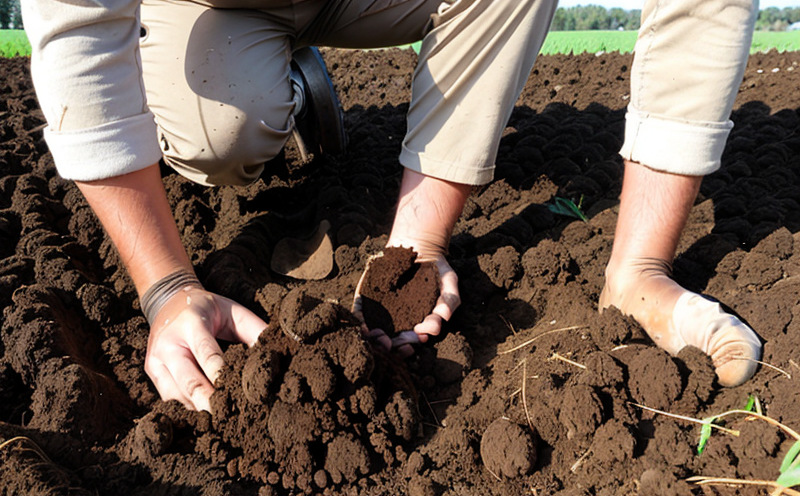Soil Chloride Content Testing Validation Method Development Test
The Soil Chloride Content Testing Validation Method Development Test is a critical process in agricultural and forestry testing aimed at ensuring the accuracy, reliability, and consistency of chloride content measurement within soil samples. Chloride levels are essential indicators for assessing environmental quality, crop health, and potential salinity issues that can impact plant growth and yield.
Chloride plays a crucial role in various biological processes; it is involved in osmoregulation, ion transport, and the maintenance of turgor pressure. Excessive chloride levels, however, can lead to toxicity in plants, affecting their root growth and overall health. This test ensures that any proposed or existing methods for measuring soil chloride content are validated against recognized standards.
The process involves several steps including sample preparation, instrument calibration, method validation, and reporting. Sample preparation is critical as it directly impacts the accuracy of the results. Samples must be representative of the field conditions to ensure reliable data. Instruments used in this testing include pH meters, conductivity meters, and ion selective electrodes.
The validity of chloride content measurements depends on proper method development and validation against recognized standards such as ISO 17294:2015 or ASTM D3248-16. This involves determining the detection limit, quantification range, precision, accuracy, linearity, and robustness of the method.
The testing process also includes quality control measures to ensure consistent results across multiple samples and different laboratories. Calibration of instruments is critical for ensuring accurate measurements. Regular audits and proficiency testing are essential components of this process.
In real-world applications, soil chloride content testing is used in various scenarios such as assessing the impact of irrigation water on soil quality, monitoring salt accumulation from industrial waste, and evaluating the effectiveness of remediation efforts post-contamination. This test is particularly important for regions prone to high salinity levels where agricultural productivity can be significantly impacted.
The results of this testing are used by quality managers, compliance officers, R&D engineers, and procurement teams to make informed decisions about soil management practices, irrigation strategies, and remediation efforts. The data obtained from these tests can help in the development of sustainable farming practices that enhance crop yield while minimizing environmental impact.
Why It Matters
The importance of chloride content testing cannot be overstated, especially in agricultural and forestry sectors. Chloride is a key component in the balance of soil nutrients, but its excessive presence can lead to detrimental effects on plant health and productivity.
In agriculture, accurate chloride content measurement helps in identifying potential salinity issues that can affect crop yield and quality. This information is crucial for developing effective irrigation strategies and fertilization practices. In forestry, chloride testing aids in assessing the impact of industrial activities on forested areas, ensuring sustainable management practices.
The precision of this test also impacts broader environmental considerations. By accurately measuring soil chloride content, we can better understand and mitigate the effects of salinity on ecosystems. This is particularly important in coastal regions where seawater intrusion into freshwater sources can lead to increased chloride levels in soils.
Furthermore, compliance with international standards ensures that testing methods are consistent across different regions and laboratories. This not only enhances reliability but also fosters collaboration among researchers and practitioners globally. The accurate and reliable data obtained from this test can contribute significantly to the development of policies aimed at sustainable land use and environmental protection.
Industry Applications
| Application | Description |
|---|---|
| Evaluating Irrigation Water Quality | Determining the chloride content in irrigation water to assess its impact on soil salinity. |
| Monitoring Industrial Waste Impact | Assessing the accumulation of chloride from industrial waste materials in agricultural and forestry soils. |
| Evaluating Remediation Efforts | Measuring chloride levels before and after remediation to gauge effectiveness. |
| Precision Agriculture | Providing data for precision irrigation strategies tailored to specific crop needs. |
| Environmental Compliance | Ensuring compliance with environmental regulations related to soil quality and salinity issues. |
| Sustainable Farming Practices | Supporting the development of sustainable farming practices that enhance crop yield while minimizing environmental impact. |
| Forestry Management | Aiding in the assessment and management of forested areas affected by industrial activities. |
International Acceptance and Recognition
The Soil Chloride Content Testing Validation Method Development Test is widely recognized and accepted in the international community. Compliance with standards such as ISO 17294:2015 or ASTM D3248-16 ensures that testing methods are consistent, accurate, and reliable across different regions and laboratories.
This global acceptance fosters collaboration among researchers, practitioners, and policymakers from various countries. The standardized approach to chloride content measurement enhances the reliability of data, which is crucial for making informed decisions about soil management practices, irrigation strategies, and remediation efforts.
The international recognition also contributes to the development of sustainable land use policies that aim to protect ecosystems and enhance agricultural productivity. By adhering to these standards, laboratories can ensure their testing methods are up-to-date with global best practices and contribute positively to environmental conservation efforts.





